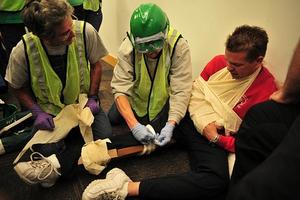DisastersU.S. cities preparing for disasters
In the last year the United States, among other challenges, faced Hurricane Sandy, the Sandy Hook shooting, the Boston Marathon bombings, and Tornadoes in Oklahoma. The future is unpredictable, so cites across the United States are taking steps to be in a better position to respond to disasters.

CERT team members train in first aid to disaster victims // Source: utah.gov
In the last year the United States, among many other natural and made-made disasters, faced Hurricane Sandy, the Sandy Hook shooting, the Boston Marathon bombings, and Tornadoes in Oklahoma.
The future is unpredictable, so cites across the United States are taking steps to be in a better position to respond to disasters. USA Today reports that many of the preparedness plans focus on how to protect critical infrastructure and how to keep critical systems functioning during and after a natural and man-made disaster.
“Every city will define it differently, but simply put it is the ability of your citizens to bounce back,” Brooke Smith, New Orleans’ director of strategic partnerships told USA Today.
Many of these plans are taking into account that large, unpredictable forces such as rising sea levels, global pandemics, and terrorism.
The Rockefeller Foundation announced last month that it will fund “Chief Resilience Officer” (CRO) positions in 100 cities worldwide for five years. CROs will work to ensure cities will “emerge even stronger from these kinds of shocks and stresses,” Rockefeller president Judith Rodin told USA Today. “We can’t predict everything, but we can prepare for many things and prepare our capacity to rebound more effectively when they hit.”
CROs will have a wide range of duties, including developing a communications system that can reach anyone during a storm, or a transportation system to get people to safety in the event of a hurricane or weather-related disaster
The CRO idea was taken from Israel, where cities were forced quickly to recover from suicide bombings and other terrorist attacks. According to Rick Nelson of the Center for Strategic and International Studies, Israelis use the quick turnarounds between an attack and things running smoothly again as a way of showing terrorists they cannot cripple the Israeli society and economy. Nelson believes showing terrorists they will not win and getting life back to normal is the key to resilience.
“The Israelis are very good at this, and we can take a lot of lessons from this area,” Nelson told USA Today.
“In a free and open society you’re always going to be somewhat vulnerable to these types of attacks,” Nelson said. “So the best thing you can do is to be able to prepare yourself to recover quickly.”
Currently, no U.S. city has a CRO, but according to Tammy Zborel of the National League of Cities, many cities are beginning to develop plans with the big picture in mind.
An example of resilience planning done correctly was the response immediately after the Boston Marathon bombings. Emergency response officials from several jurisdictions in the area spent two years training for such an event. After the bombs went off there was “a combined, collaborative, well-thought-out response,” James Baker, a retired assistant sheriff from Alameda County, California, told USA Today.
